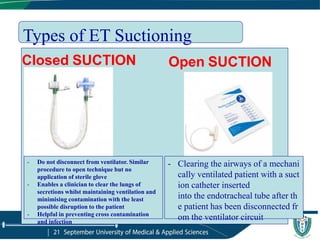5-Airway eeeeeeeeeeeeeeeeeeeeeefsuctioning.pdf
- 3. Supervised by Asso. Prof. Ameera Al-Sumat, MD Senior Consultant Internist & Pulmonary diseases Deanship of Graduate Studies and Scientific Research 21 September University of Medical & Applied Sciences Abdulrahman Al-Huthifi Student of Master of Science in Respiratory Care Deanship of Graduate Studies and Scientific Research 21 September University of Medical & Applied Sciences
- 6. 1. Terminology 2. Definition of suctioning . 3. Sites for suction . 4. Difference between oropharengyeal / nasopharyngeal suctioning and endotracheal / tracheostomy suctioning . 5. Purposes for suctioning . 6. Indications for suctioning. Outlines
- 7. 7. Choosing the right size catheter. 8. Setting the correct pressure . 9. Documentation. 10.Complications of suctioning . Outlines Cont.
- 8. ŌĆó Airway Suction: The removal of airway secretions/foreign material by artificial means, using an applied negative pressure ŌĆó Yankauer Suction Catheter: A rigid suction tip used to aspirate secretions from the oropharynx ŌĆó Oropharyngeal Suction: (OP) requires the use of an airway adjunct (Guedel Airway) ŌĆó Nasopharyngeal Suction: (NP) may be undertaken directly via the nostril without an airway adjunct. If repeated suction is anticipated a nasopharyngeal airway should be utilised. This is inserted only by those that are trained to do so. ŌĆó Suction is an invasive procedure and should NOT be carried out on a routine basis. But, suctioning is an integral part of the management of intubated/ventilated patients. Terminology
- 9. Is 'the mechanical aspiration of pulmonary secretions from a patient with an artificial airway in place'. The procedure involves patient preparation, the suctioning event(s) and follow-up care Definition
- 14. Endotracheal/Tracheostomy suctioning Oropharyngeal /Nasopharyngeal suctioning Remove secretion from the trachea and bronchi or the lower respiratory tract . Remove secretion from the upper respiratory tract . Difference between Oropharyngeal /Nasopharyngeal suctioning and Endotracheal/ tracheostomy suctioning
- 15. Oral / Nasal suction 1- maintain oral/ nasal hygiene. 2- comfort for the patient. 3- remove blood and vomit in an emergency situation. Purposes Of Suctioning :-
- 16. Tracheal/ Endo- tracheal suction To maintain a patent airway by removing retained tracheobroncheal secretions. To prevent lower respiratory tract infection from retained secretions. To provide effective ventilation. To stimulate coughing. Purposes Of Suctioning :-
- 18. Therapeutic Indications ’éó Noisy breathing ’éó Visible secretions in the airway ’éó Decreased SpO2 in the pulse oximeter & Deterioration of arterial blood gas values ’éó PatientŌĆÖs inability to generate an effective spontaneous cough ’éó Presence of pulmonary atelectasis or consolidation, presumed to be associated with secretion retention ’éó During special procedures like Bronchoscopy& Endoscopy
- 19. Diagnostic Indications Indication ’éó The need to obtain a sputum specimen / E T A (Endo Tracheal Aspiration) for investigations.
- 20. Choosing the right size catheter OPAs are made in various sizes. The correct size OPA should track from the corner of the patient's mouth to the angle of the jaw. Insertion of an OPA of incorrect size may push the tongue back toward the pharynx creating an obstruction. Size Age #12 to #18 Adult #8 to # 10 Children # 5 to #8 Infant
- 21. Choosing the right size catheter Estimating NPA length by measuring the distance from the tip of the nose to the tragus of the ear has not been validated in adults. A study in Chinese children found a close association between nares-vocal cord distance and nose tip- earlobe distance, with the ideal NPA length being slightly less than this anthropometric measurement Size Age #12 to #18 Adult #8 to # 10 Children # 5 to #8 Infant
- 22. Setting the Correct Pressure Portable Unite Wall Unit Age 10 to 15 mm Hg 100to 120 mm Hg Adult 5 to 10 mm Hg 95 to 110 mm Hg Child 2 to 5 mm Hg 50 to 95 mm Hg Infant
- 23. Types of ET Suctioning Closed SUCTION - Do not disconnect from ventilator. Similar procedure to open technique but no application of sterile glove - Enables a clinician to clear the lungs of secretions whilst maintaining ventilation and minimising contamination with the least possible disruption to the patient - Helpful in preventing cross contamination and infection Open SUCTION - Clearing the airways of a mechani cally ventilated patient with a suct ion catheter inserted into the endotracheal tube after th e patient has been disconnected fr om the ventilator circuit
- 24. Patient Preparation ’āś Explain the procedure to the patient if conscious. ’āś The patient should receive hyper oxygenation by the delivery of 100% oxygen for >30 seconds prior to the suctioning ’āś Position the patient in supine position. ’āś Auscultate the breath sounds.
- 25. ASSESSMENT Patient should be monitored prior to, during & after the procedure for following : ’āś Breath sounds ’āś Oxygen saturation ’āś Respiratory Rate & pattern ’āś Hemodynamic parameters (pulse rate, Blood pressure) ’āś Cough effort ’āś ICP (If indicated and available) ’āś Sputum characteristics (color, volume, consistency & odor) ’āś Ventilator parameters (PIP, Vt & FiO2)
- 26. EQUIPMENT ASSEMBLYING ’āśStethoscope ’āśVacuum source with adjustable regulator suction jar ’āśSterile gloves ’āśSterile suction catheter ’āśProtective goggles, apron & mask ’āśSterile normal saline ’āśAMBU bag for pre & post oxygenation
- 27. Documentation ŌĆó Record the procedure : Ō×óThe amount . Ō×óConsistency . Ō×óColor . Ō×óOdor of the mucus . Ō×óClient breathing status before and after.
- 28. COMPLICATIONS ’āśHypoxia ’āśTracheal or bronchial mucosal trauma ’āśCardiac or respiratory arrest ’āśPulmonary hemorrhage / bleeding ’āśCardiac dysrhythmias ’āśPulmonary atelectasis ’āśBronchospasm ’āśHypotension / hypertension ’āśElevated ICP
- 29. A Name is Better Than riches. ŌĆ½ž¦┘䞣ž│┘åŌĆ¼ ŌĆ½ž¦┘䞥┘Ŗž¬ŌĆ¼ ... ŌĆ½ž¦┘ä┘ģž¼┘ģ┘łž╣ŌĆ¼ ŌĆ½ž¦┘ä┘ģž¦┘äŌĆ¼ ŌĆ½┘ģ┘åŌĆ¼ ŌĆ½ž«┘Ŗž▒ŌĆ¼
- 30. Have a great day





























